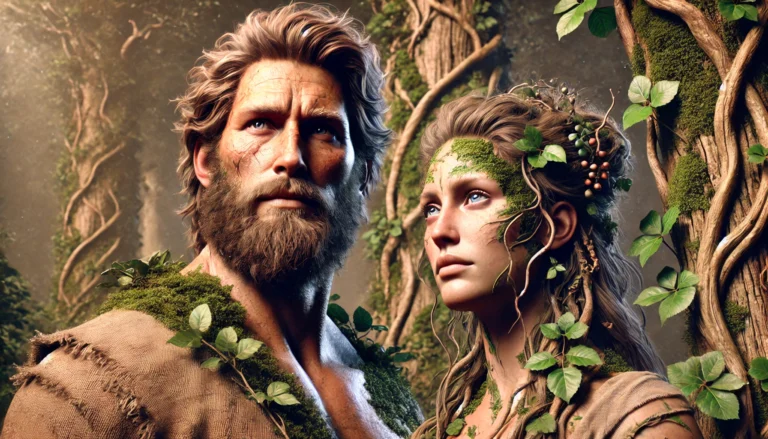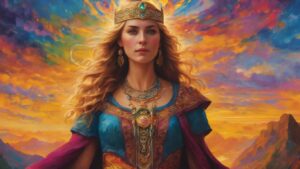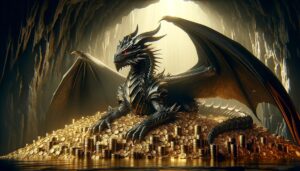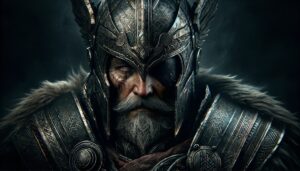Table of Contents
Origins
In the vast, ancient world of Norse mythology, the tale of Ask and Embla marks the dawn of human existence. These two figures, the first man and woman, were brought to life by the Aesir gods—specifically, Odin, Vili, and Ve. This divine triad, central to Norse cosmogony, discovered two lifeless logs on the seashore. These logs, devoid of vitality and identity, were transformed through the gods’ combined powers, igniting the spark of humanity.
Odin, the all-father and chief of the gods, imbued them with the breath of life, gifting them with the essence of spirit. Vili, often associated with will and thought, endowed them with understanding and the ability to move, while Ve, the god of sanctity and sight, bestowed upon them their senses, emotions, and outward appearance. Thus, from the inert timber, Ask and Embla were born, ready to inhabit the world fashioned by the gods.
Appearance
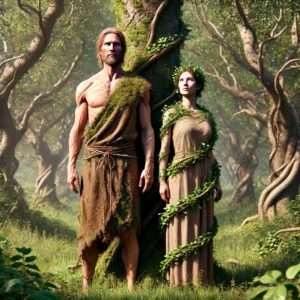
Ask and Embla, in their newfound humanity, were envisioned as the archetypal ancestors of all humans. The first man, is often depicted as tall and robust, embodying strength and resilience. His name, meaning “ash tree,” signifies endurance and the capacity to thrive in harsh conditions. Embla, the first woman, is equally revered, her name believed to be derived from “elm” or “vine.” Her representation speaks to nurturing and flexibility, essential traits for the continuation of their lineage.
Both were bestowed with an inherent connection to nature, their names deeply rooted in the elements of the earth. This connection highlights their role as the progenitors of the human race, emphasizing the symbiotic relationship between humans and the natural world.
Abilities and Weaknesses
As the first humans, Ask and Embla possessed no supernatural abilities. However, their creation endowed them with unique qualities that set the foundation for human traits. They were given consciousness, intelligence, and the ability to experience a wide range of emotions. These attributes distinguished them from other beings in the Norse cosmos, making them distinctively human.
Their weaknesses, however, lay in their mortality and vulnerability to the elements. Unlike the gods, Ask and Embla were not immortal. They were subject to aging, illness, and the hardships of life, reflecting the human condition. Their mortality served as a reminder of the fleeting nature of life and the importance of living with purpose and resilience.
Behavior with Humans
Ask and Embla, as the first humans, did not interact with others of their kind initially. Their significance lies in their role as the ancestors of humanity, and through their lineage, the human race proliferated. The gods’ act of creating Ask and Embla was a profound gesture, symbolizing the divine intention for humans to populate and prosper in Midgard, the world of men.
Over time, the descendants of Ask and Embla spread across the earth, forming tribes and communities. Their legacy persisted through the values and characteristics passed down to subsequent generations. The story of Ask and Embla became a cornerstone of Norse culture, emphasizing the divine origins of humanity and the responsibilities bestowed upon them by the gods.
Symbols and Representation

The symbols associated with Ask and Embla are deeply intertwined with their names and creation. The ash tree, representing Ask, is a powerful symbol of strength, endurance, and the interconnectedness of life. Moreover, ash trees were considered sacred in Norse mythology, often associated with Yggdrasil, the World Tree that connects all realms.
Additionally, Embla’s association with the elm or vine symbolizes growth, flexibility, and fertility. These symbols, therefore, highlight the nurturing aspects of humanity and the capacity for adaptation and survival. Together, these symbols represent the duality of human nature—strength and nurture, endurance and flexibility.
Related Myths and Stories
The creation of Ask and Embla is but one chapter in the rich tapestry of Norse mythology. Their story is closely linked to the cosmological narratives that describe the formation of the world. According to the myths, before the creation of humans, the cosmos consisted of various realms, each inhabited by different beings, including gods, giants, dwarfs, and elves.
The Aesir gods, including Odin, Vili, and Ve, played pivotal roles in shaping the world. They battled the primordial giant Ymir, from whose body they fashioned the earth, sea, and sky. In this newly formed world, Midgard was created as a habitable realm for humans. The creation of Ask and Embla marked the culmination of these efforts, introducing humanity into the divine plan.
Other Creatures with Similar Traits

Within Norse mythology, other beings share traits with Ask and Embla, particularly in their origins and roles. The dwarfs, for instance, were also crafted from elements of nature. They were initially formed from the maggots in Ymir’s flesh, later shaped by the gods into intelligent and skilled artisans. Although not human, their creation from natural elements parallels the genesis of Ask and Embla.
Another parallel can be drawn with the Vanir gods, who, like the Aesir, had a profound connection to nature. The Vanir were associated with fertility, prosperity, and the natural world, embodying traits that resonate with the nurturing aspects of Embla. The interactions and occasional conflicts between the Aesir and Vanir further enriched the mythological landscape, highlighting the diverse forces that shaped the world.
FAQ
How were Ask and Embla created?
The gods Odin, Vili, and Ve discovered two logs on the beach. Odin gave them life, Vili endowed them with intelligence and movement, and Ve bestowed senses and appearance, thus creating Ask and Embla.
What do their names mean?
Ask's name is derived from "ash tree," symbolizing strength and endurance. Embla's name is believed to mean "elm" or "vine," representing growth and nurturing.
What attributes were given to Ask and Embla by the gods?
Odin gave them the breath of life, Vili gave them understanding and the ability to move, and Ve gave them senses, emotions, and appearance.
Do Ask and Embla have any supernatural abilities?
No, Ask and Embla do not possess supernatural abilities. They were created with human traits such as consciousness, emotions, and physical senses.
What is their significance in Norse mythology?
Ask and Embla are significant as the progenitors of the human race. Their creation marks the beginning of humanity's presence in Midgard, the world of men, according to Norse mythology.
What symbols are associated with Ask and Embla?
Ask is symbolized by the ash tree, representing strength and resilience. Embla is symbolized by the elm or vine, representing growth and nurturing.
How do Ask and Embla relate to other beings in Norse mythology?
While unique as the first humans, Ask and Embla's creation from natural elements is paralleled by other beings, such as dwarfs, who were also formed from natural elements by the gods.
What is the cultural significance of their story?
The story of Ask and Embla reflects the Norse belief in the divine origin of humanity and the deep connection between humans and nature. It underscores themes of life, mortality, and the legacy of human actions.
Are there any related myths to their creation?
Yes, their creation is part of a larger narrative involving the formation of the world by the Aesir gods, including the battle with the primordial giant Ymir and the establishment of Midgard.
What role did Ask and Embla play after their creation?
Ask and Embla did not have direct interactions with others initially but are considered the ancestors of all humans, through whom humanity proliferated and formed tribes and communities.
How does their story influence modern interpretations of Norse mythology?
The story of Ask and Embla continues to influence modern interpretations by emphasizing the divine connection in human origins, the importance of nature, and the central themes of life and mortality in Norse mythology.
